Mission: Impact podcast & blog
Build a better world without becoming a martyr to your nonprofit cause
Listen on:
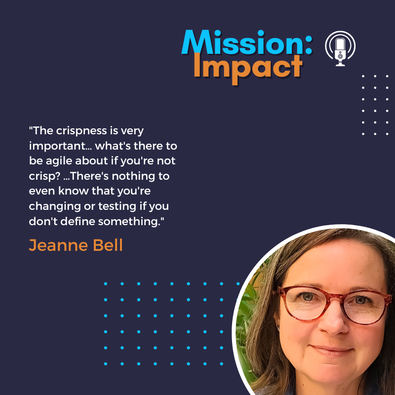 In episode 69 of Mission: Impact, Carol and her guest, Jeanne Bell discuss:
Guest Bio: Jeanne Bell is co-founder of JustOrg Design. She has consulted on nonprofit strategy and organizational change for over 20 years. Jeanne curates Nonprofit Quarterly's Leading Edge Program, recruiting and presenting nonprofit practitioners advancing more equitable nonprofit leadership practices. Previously, Jeanne led CompassPoint Nonprofit Services, one of the country's premier leadership and capacity-building organizations. While serving as CEO, Jeanne also chaired the board of the Alliance for Nonprofit Management, a national association of nonprofit capacity builders and academics. She currently serves on the boards of Community Works and Borealis Philanthropy. She has a Masters in Nonprofit Management from the University of San Francisco. Jeanne loves living in San Miguel de Allende, Mexico. Important Links and Resources:
Click "Read More" for Transcript: 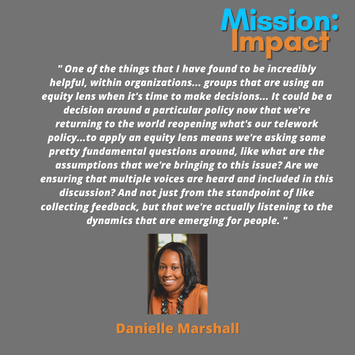 In episode 56 of Mission: Impact, Carol and her guest, Danielle Marshall discuss:
Guest Bios: Danielle is an inclusive leader focused on strengthening collaboration among teams, leaders, and stakeholders to foster problem-solving, create solutions, and improve culture. She finds inspiration in leading systemic change work that promotes equity and inclusion. Danielle has worked in the nonprofit sector for 20+ years most recently having served as the Executive Director for Playworks Mid-Atlantic. Danielle went on to found Culture Principles in response to a persistent need to move organizations beyond DEI statements to develop strategic and actionable equity goals. Danielle holds a Master's degree in Industrial-Organizational Psychology from Louisiana Tech University and draws on her background as an I/O psychologist in applying a racial equity lens to organizational policies, practices, and programs. She is a Certified Diversity Professional (CDP)/Executive Coach. Important Links and Resources:
Click "Read More" for Transcript: Helping nonprofits boards move toward greater equity with Christal Cherry and Renee Rubin Ross8/23/2022
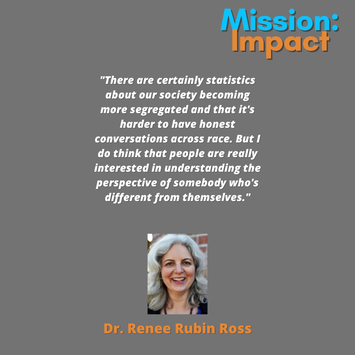 In episode 55 of Mission: Impact, Carol and her guests, Dr. Renee Rubin Ross and Christal Cherry discuss:
Guest Bios: Dr. Renee Rubin Ross is a nationally recognized strategic planning and board development consultant. Committed to racial equity in the nonprofit sector, Dr. Ross supports organizations and individuals in practices that celebrate and amplify diverse voices and perspectives. Christal M. Cherry is a nationally recognized nonprofit executive and professionally trained fundraiser. With over 20 years in the nonprofit sector, she has supported higher education institutions, human services organizations and faith-based missions. Her career portfolio, as a full time professional and consultant includes American University, the United Negro College Fund, Spelman College, Nicholas House, the Interdenominational Theological Center, Florida A & M University, Action Ministries, and the GA Center for Nonprofits. In each role, Christal has interfaced, guided and collaborated with diverse boards made up of college presidents, ministers and bishops, politicians, corporate CEO's, civic leaders, consultants, attorneys, stay at home moms and students. With passion and a wide breadth of experience, Christal works today with clients to help them mark a clear path to success in board development. Her style is electrifying, inspiring, and energizing. Christal earned a MA in Counseling from Hampton University, a BA in Liberal Arts from Hofstra University and professional development certifications in nonprofit leadership, social media fundraising, and nonprofit management. She currently serves on the board of the Greater Atlanta chapter of the Association of Fundraising Professionals and the Villages of Carver YMCA. She is regular presenter with CANDID, Qgiv, Network for Good, Bloomerang, and the Mississippi Alliance of Nonprofits and Philanthropy where she facilitates webinars and teaches courses in fundraising, board development and equity and inclusion. Christal has been a guest on multiple podcasts and enjoy serving as a requested expert on board matters. She is contributing author in Collecting Courage, a documenting of racism and survival by 14 accomplished Black fundraisers working across North America. She also enjoys her membership in the African American Development Officers Network, Toastmasters, and F3, Fabulous Female Fundraisers which she founded. Important Links and Resources:
Click "Read Morea" for Transcript: 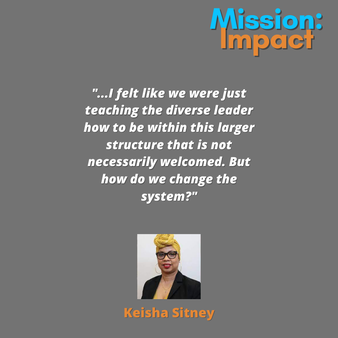 In episode 39, Carol Hamilton looks back at the last year and a half of Mission Impact. Using clips from interviews with Tip Fallon, Nyacko Perry, Carlyn Madden, Kristin Bradley-Bull, Keisha Sitney, Rosalind Spigel, Stephen Graves and Nathaniel Benjamin, she examines:
Learn more about my featured guests:
Click "Read More" for Transcript: 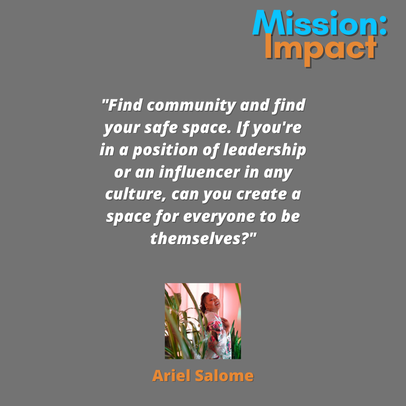 This episode is part of the Culture Fit project that Carol recorded with her son-in-law Peter Cruz. In this episode, Carol, her cohost Peter Cruz, and their guest Ariel Salome discuss:
Guest bio: Ariel Salomé thrives on challenging assumptions and limiting beliefs, reframing challenges into opportunities. She possesses the uncanny ability to constructively disturb the status quo to the point where it opens the floodgates of possibilities, leading to transformation. For the past 18 years, Ariel has served as a training & curriculum designer, DE&I practitioner and group process facilitator. She just returned to California from Washington D.C. where she managed National Science Foundation grant-funded projects in STEM higher education reform, supporting the development of STEM faculty leaders across the nation. Ariel is now known as the “Corporate Healer” as she coaches and develops the next generation of leaders in tech as the PM for Leadership Development at Lyft. Ariel is also the founder and space holder for METANOIA, a spiritual community of practice. Ariel received her BA in Sociology and dialogue facilitation training at Occidental College. She completed ICF comprehensive coaching certification and doctoral-level training in human and organizational development at Fielding Graduate University. Her research and practice include transformative learning, ontological coaching, and the somatic release of intergenerational and racialized trauma. She believes that the world’s greatest problems can find solutions when we show up as fully human and fully divine. Important Links and Resources:
|
Archives
April 2024

Grace Social Sector Consulting, LLC, owns the copyright in and to all content in and transcripts of the Mission: Impact podcast, as well as the Mission: Impact blog with all rights reserved, including right of publicity.
|
Telephone301-857-9335
|
info[at]gracesocialsector.com
|
Grace Social Sector Consulting, LLC, owns the copyright in and to all content in, including transcripts and audio of the Mission: Impact podcast and all content on this website, with all rights reserved, including right of publicity.
|